Other than meat, dairy and eggs, nearly everything we eat can trace its roots to an angiosperm aka “flowering plant“. Angiosperms are over 140,000 million years old, and their lineage traces back to a branch from gynosperms (seed producing plants that don’t wrap their seeds in fruits) over 200,000 million years ago. Since then they have exploded into between some 250,000 to 400,000 distinct species and have adapted to virtually any environment.
All angiosperms follow a distinct lifecycle: seed → germination → sprout → leaf → flower → fruit and then death (annuals) or repeat (perennials). Regardless of the parent plant’s survival or demise, the seeds of the next generation sit safely ensconced in the fruit that is the culmination of each growing seasons trials and tribulations.
Barbara Kingsolver walks readers of Animal, Vegetable, Miracle through the life cycle of the “vegetannual” as a means “to recover an intuitive sense of what will be in season throughout the year”. This helps you recognize what was likely flown, trucked, trained, or boated to your grocery store from thousands of miles away, even when the stores do their best to hide the seasons from us.
The vegetannual is a single plant that produces an entire seasons worth of food. The seed of the vegetannual will germinate shortly after the last frost when the ground begins to warm. From the germinated seed, a root shoots downward, two seed leaves pop and a true leave shoot sprouts upwards. Eventually sunlight awakens the chloroplasts in the true leaves, and from then on the seedling is on its own.
Now the leaves start to multiply and “spinach, kale, lettuce and chard (April – May)” are ready to be picked off the vegetannual. The leave heads continue to mature so next comes “cabbage, romaine, broccoli and cauliflower (May – June).” Flowers lead to fruit so early immature edible fruits are the next to the dinner plate: “snow peas, baby squash, cucumber (June), followed by green beans, green peppers, and small tomatoes (July).” Next comes large “tomatoes, eggplants, red and yellow peppers (late July – August)”. Finally your mature hard fruits are ready, like melons, pumpkins and apples (August – September). Last are the root crops: potatoes, sweet potatoes, beets and turnips (autumn – winter).
If you can remember that the order of things is “leaves, buds, flowers/green fruits, ripe fruits, hard fruits”, then roots, and that each stage lasts for about a month or two beginning near April, then you’ll have a good idea what’s in season without having to read the fine print.
What are your favorite fruits or vegetables? If you haven’t been aware of their true season before, can you make a guess at what their season is now? How close were you?
Last week we started to get snow peas from my first raised garden bed. After completing a third bed I jokingly referred to the first pea we took as our “500 dollar pea”. If I counted my time too and not just the material it would have been worth an even more exorbitant sum! As tasty as it was I am sure no one would pay that much for a pea, even a fresh local organic one! Luckily each snow pea I pick reduces the cost significantly. Now that I’ve picked 10 of them, each would have only been 50 dollars a piece; I’m almost willing to pay!
Lolo’s Dad






Hope the peas were delicious and worth all the time and effort!
It was a lot of effort, but it’s been a ton of fun too! No way I would have done all of this if I wasn’t also having a blast, I’m too lazy 🙂 The peas were great! It’s funny because now I’m a pea snob. We wanted a handful of snow peas for a meal this week, so we got some at the grocery store. Most of them were limp and a few had spots; all of which filled me with even more pride for my own peas!
Since I moved to France, I have really started eating mostly what is in season. Because so many fruits and vegetables can be grown here, usually just seeing “France” on the country of origin label, is enough to indicate whether something is in season! Also, the supermarkets usually are more full of whatever ever is in season at the moment (eg strawberries and cherries at the moment).
We just picked up strawberries and cherries too! France or California, I think we are pretty lucky with the climate!
I’m glad you’re getting peas! This Sacramento heat always tends to kill my peas off WAY before their time, since I love peas from the garden. I watched “The Botany of Desire” on Youtube this weekend, and Pollen had lots of interesting things to say about angiosperms. 🙂
Hey, thanks for commenting! Hope your big day goes smooth! Thanks for pointing out the Botany of Desire. Just watched the trailer; we’ll be watching it soon!
Don’t feel bad about your pricey peas…can’t even tell you how much we’ve really spent on our $5 ducks! 😉 PS, thx for the reminder about the pleasures of seasonal eating!